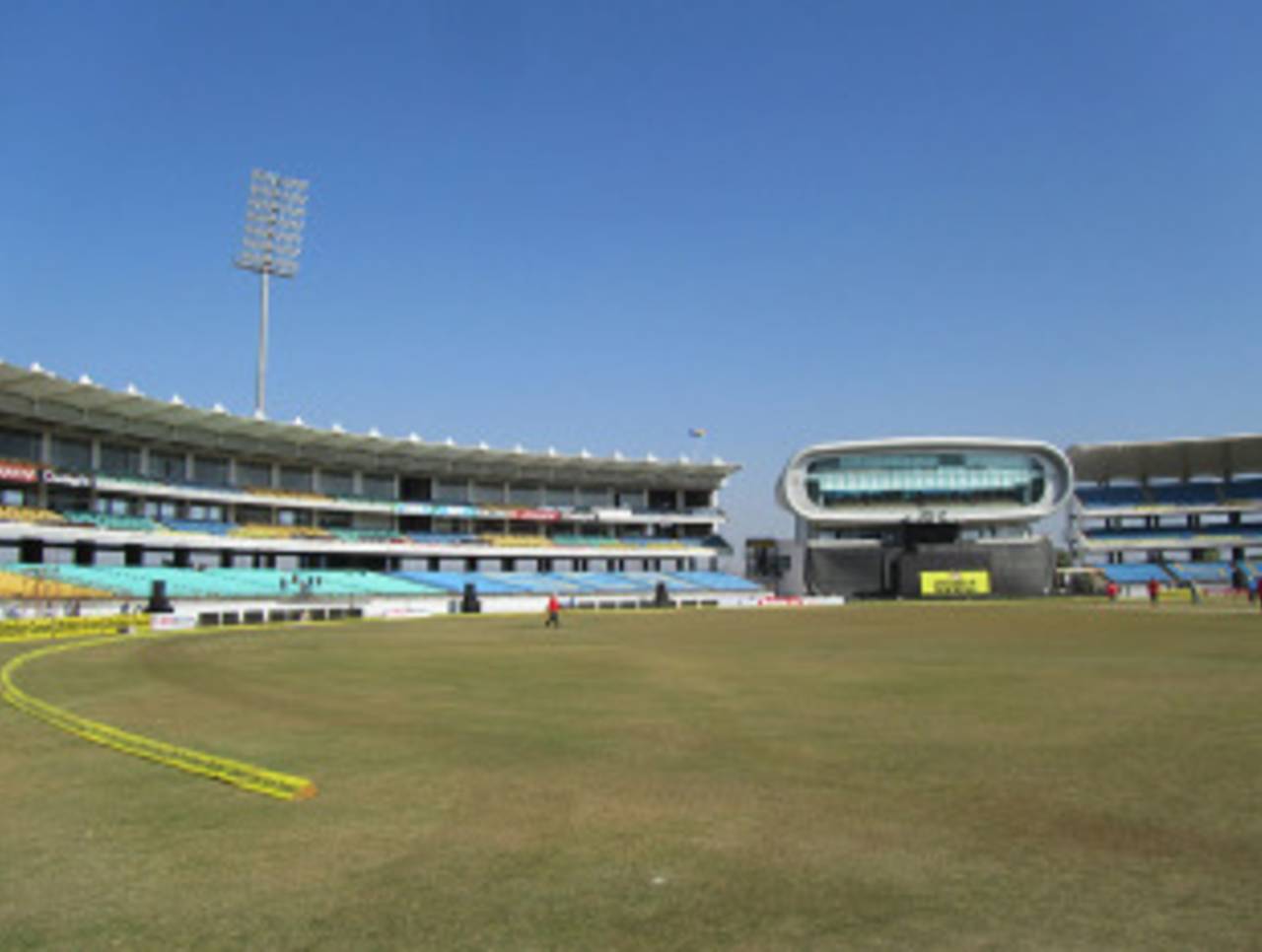Rajkot stadium ready for proud debut
Among the unique features of the newly-built Saurashtra Cricket Association Stadium are the lack of pillars, the canopies and the Lord's-style media capsule
Abhishek Purohit in Rajkot
10-Jan-2013

The new stadium at Khanderi doesn't have a single pillar, giving spectators an unobstructed view of the field • ESPNcricinfo Ltd
Niranjan Shah is a busy man, reeling off instructions and overseeing work as varied as setting up a television set, installing electrical equipment and painting walls. The Saurashtra Cricket Association secretary is also an immensely proud man as finishing touches are being applied to what has been a long-cherished dream for him. The SCA's splendid new stadium in Khandheri, just outside Rajkot, is ready to make its international debut. On Friday, January 11, India and England will meet here under floodlights in the first of five ODIs.
Rajkot is usually in the cricket news whenever its run machines Cheteshwar Pujara and Ravindra Jadeja make their latest double or triple-hundred. It can now also boast of a world-class international venue. What strikes you as soon as you enter the stadium is the sense of space, something you don't get often in India. Space has been kept in mind everywhere. The stadium capacity has been limited to around 28,000. To facilitate spectator movement, there are several aisles between seat columns and lots of entrances/exits for the three stands. There is also a spacious passage running around the stadium, between the stands and the outer wall, to enable easy movement.
Madhukar Worah, the SCA joint secretary, points out the absence of pillars in the stands, a trend in modern stadiums. "There is not a single pillar," Worah says. "It is to give fans an unobstructed view of the field." The stadium itself has been constructed on a raised plinth, a few feet above ground level. "Wherever you are sitting, you will get an excellent view, even from the lower rows," Shah says.
Worah says the SCA was one of the first associations not having its own ground to take steps towards building one - a policy that paid off when the BCCI started favouring associations with their own grounds when awarding international matches. The SCA itself was tired of having to haggle with the Rajkot municipal authorities for use of the Madhavrao Scindia ground in the heart of the city, where 11 ODIs have been staged. A 30-acre portion of agricultural land next to the Jamnagar highway was acquired around 2004. Construction began in 2006 and the total cost, including land, is said to be around Rs 75 crore (around US$ 14 million). The SCA will soon shift its offices from the cramped seventh floor of a commercial building in the city to the stadium, which has been hosting first-class matches since late 2008.
The complex has two playing fields: the main one inside the stadium, with a 90-yard outfield, and a smaller one outside, with a 70-yard outfield. The latter is used for outdoor nets, and also for district-level matches. The dressing rooms are big and lined with large, luxurious, cushioned seats. There are more than 60 hospitality boxes dotting the West Stand and the Pavilion Stand but the SCA has decided against selling them permanently to corporates and will only hire them out for international matches.There are even plans to have an academy in the future - Worah says young players from around Saurashtra can stay at the ground, till the academy takes shape - but Shah's focus now is the England ODI.
Of course, the inspiration was Lord's. We wanted to create something that stands out.Niranjan Shah on the Lord's-style press box
While giving players and fans their space, the SCA has also made sure none of it is wasted. The area beneath the spaceship-style media capsule, modelled on the lines of the one at Lord's, has been utilised for an indoor nets facility. The image of the media capsule, which Shah claims can hold upto 150 journalists, stays with you when you leave the stadium.
"Of course, the inspiration was Lord's," Shah says. "We wanted to create something that stands out. In fact, there is a different theme to each of the stands." The West Stand has around 20 mini-canopies as a roof, reminding you a bit of Adelaide Oval.
Maintaining the substantial outfield is a challenge in Rajkot, where water is scarce and the ground-water table tends to go dry by February, months before the next monsoon arrives. The SCA has to resort to purchasing water from tankers run by private operators. It's part of life in Saurashtra - Worah says there is no water in his house and he is expecting guests.
Meanwhile, Shah moves around, checking electrical work going on in the media capsule, and keeping an eye on the proceedings in the Saurashtra-MP game, which the home side goes on to win to make the Ranji knockouts. He reaches the scorers' cabin near the dressing rooms, himself lugging a television in, and shouts for someone to come with a set-top box. January 11 is going to be a proud day for Rajkot and Saurashtra, and Shah does not want to leave anything to chance.
Abhishek Purohit is a sub-editor at ESPNcricinfo